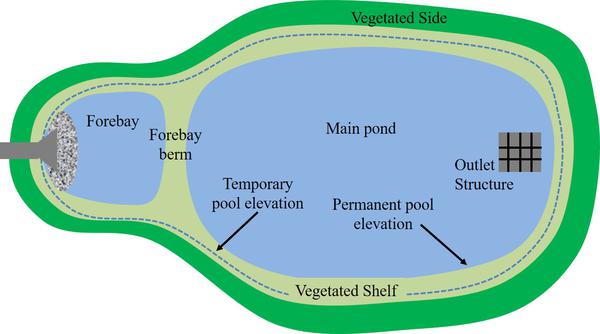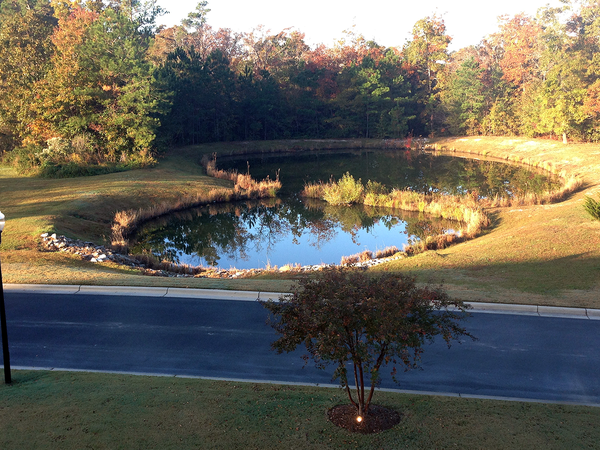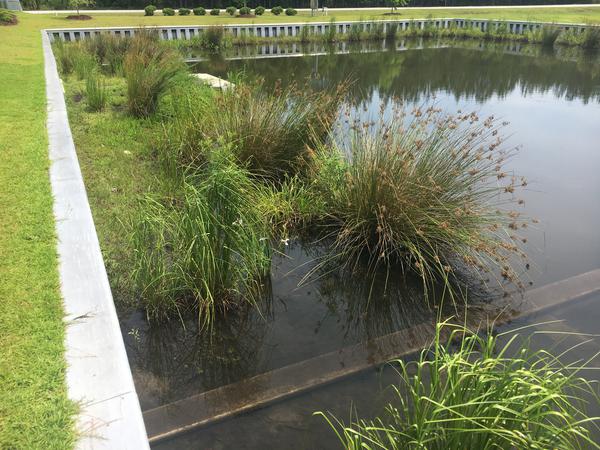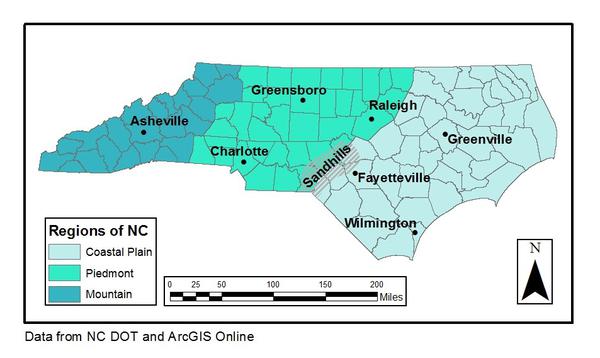Introduction
Urbanization often leads to more expansive municipal infrastructure including roadways, residential housing, and commercial areas. Development is accompanied by increases in impervious surfaces and decreases in vegetative land cover. Less pervious area reduces stormwater infiltration while less vegetation means less evapotranspiration of water. This contributes to increased flooding and stream channel erosion. As the water flows over these surfaces, it picks up pollutants such as sediment, nutrients, metals, and bacteria and delivers them to waterways. These pollutants can be harmful to the environment and may contribute to eutrophication, algae blooms, low dissolved oxygen, and fish kills. To mitigate for these hydrologic changes and pollution inputs from stormwater flows, Stormwater Control Measures (SCMs), also called Best Management Practices (BMPs), have been developed. The goals of SCMs are to reduce runoff volume, mitigate peak flow rates, and improve water quality through a number of mechanisms including evapotranspiration, infiltration, detention, sedimentation, filtration, and biological/chemical activity. One of the most common SCMs is the wet retention pond (hereafter referred to as wet ponds).
Wet Ponds
Originally designed to control flooding during major storms, wet ponds were later adapted to improve stormwater quality. Wet ponds are basins that typically receive runoff from a mid-sized watershed (5 to 50 acres). They are designed to have a permanent presence (or pool) of water for removing sediment and sediment-borne pollutants. Additional capacity above the permanent pool stores and slowly releases detained runoff. Water surface elevations and water releases are controlled by an outlet structure, which includes normal and emergency spillways and a drawdown orifice. The drawdown orifice sets the permanent pool elevation (PPE) and controls the rate of release of the treated stormwater. Wet ponds are designed with a forebay that collects sediment for easy removal during routine maintenance (Figure 1, Figure 2a, and Figure 2b). Wet ponds constructed since the mid-2000s may also contain a vegetated shelf along the pond’s edge (Figure 1, Figure 2a, and Figure 2b).
To promote pollutant removal, wet ponds built in North Carolina since 2017 have been required to have a 6-foot wide aquatic shelf with a 6:1 side slope along the perimeter of the pond (Figure 2a and Figure 2b). The PPE can be located anywhere along the shelf, from its outer perimeter to that of its inner. This aquatic shelf is traditionally planted with vegetation that is adapted to being inundated with water. The vegetated shelf is shallow because it is, in part, a safety feature with water too shallow to become a drowning risk.
Infiltrating Wet Pond Recommendations
To prevent a monoculture, a variety of plants should be selected for wet pond aquatic shelves. Plant diversity may enhance nitrification/denitrification capability and improves both aquatic and terrestrial habitat as well as the aesthetics of wet ponds. Per North Carolina Department of Environmental Quality (NCDEQ) guidelines, a minimum of three different species need to be selected; however, faculty at NC State University recommend at least six species. Plants must be tolerant of dry conditions and inundation. Inundation will typically not last more than three days. Dry conditions, however, could persist for a month, depending on rainfall patterns. Thus, it is important to select plants that are drought tolerant. Two naturally occurring landscapes that mimic the hydrologic pattern of an infiltrating wet pond shelf are found in the North Carolina coastal plain: pocosins and riparian (floodplain) areas. These landforms are often quite sandy and have fluctuating water table conditions that cause moisture conditions to change rapidly. Vegetation becomes inundated when the river level rises or pocosins flood but then experiences low moisture conditions during droughts. Plants that naturally grow in these areas should be ideal candidates to survive and thrive on the vegetated shelf of an infiltrating wet pond.
|
Shrubs/Perennials |
||
|
Common name |
Scientific name |
Comments |
|
Beautyberry |
Callicarpa americana |
Pink/purple berries, vibrant green leaves in warm months; deciduous; thrives in part sun |
|
Chokeberry |
Aronia arbutifolia |
Dark (black, red, or blue) berries |
|
Red star hibiscus |
Hibiscus coccineus |
Striking scarlet-colored blooms 6 inches in width in summer; grows 4 to 7 feet tall; deciduous; full sun |
|
Goldenrod |
Solidago rugose; Solidago sempervirens |
Blooms in tight clusters of small yellow flowers; blooms in fall and attracts pollinators; full sun; some consider a noxious weed |
|
Buttonbush |
Cephalanthus occidentalis |
White to pale yellow “button” flower that attracts hummingbirds; salt tolerant |
|
Possumhaw |
Viburnum nudum |
Pink and blue berries |
|
Silky dogwood |
Cornus amomum |
White flowers |
|
Virginia Sweetspire |
Itea virginica |
Fragrant white flowers; deep red fall foliage; sun to shade; deciduous; medium sized shrub growing up to 6 feet tall |
|
Sweet Pepperbush |
Clethra alnifolia |
Fragrant white flowers |
|
Joe Pye Weed |
Eutrochium fistulosum |
Mauve-pink flowers; grows up to 6 feet tall |
|
Ironweed |
Vernonia novaboracensis |
Purple flowers |
|
False Indigo |
Amorpha fruticosa |
Purple flowers |
|
Grasses |
||
|
Common name |
Scientific name |
Comments |
|
Sweet grass* |
Muhlenbergia filipes |
Filipes variant best; pink to purple flower stalks in the fall, referred to as the “queen of the garden;” tolerates shade, but performs best in sun; grows 3–4 feet in height; drought tolerant once established |
|
Switchgrass |
Panicum virgatum |
Shenandoah cultivar also acceptable. Adds texture and contrast to the shoreline; sun; grows 2 to 5 feet in height |
|
River oats |
Chasmanthium latifolium |
Oat-like seed-heads are ornamental and copper in fall; clump forming, shade; 2 to 3 feet in height |
|
Little bluestem |
Schizachyrium scoparium |
Color ranges from blue tint to red. Clumping, full sun; slender blue-green stems turn red with white seed tufts in fall; color remains in winter; grows 2 to 3 feet in height |
|
Indiangrass |
Sorghastrum nutans |
Golden seed head |
Summary
Resources
Other Resources
Baird, J. (2015). Evaluating the hydrologic and water quality performance of infiltrating wet retention ponds. (MS Thesis). Raleigh, NC: North Carolina State University.
Hunt, W. F., Apperson, C. S., Kennedy, S. G., Harrison, B. A., & Lord, W. G. (2006). "Occurrence and relative abundance of mosquitoes in stormwater retention facilities in Corth Carolina, USA." Water Science & Technology, 54(6), 315-321.
Leopold, L. B. (1968). Hydrology for urban land planning: A guidebook on the hydrologic effects of urban land use. Washington D.C.: United States Department of the Interior.
Mallin, M. A., Ensign, S. H., Wheeler, T. L., & Mayes, D. B. (2002). "Pollutant removal efficacy of three wet detention ponds." J.Environ.Qual., 31(2), 654-660.
NCDEQ. (2017). Stormwater design manual. Retrieved from https://deq.nc.gov/sw-bmp-manual
North Carolina Department of Environmental Quality—Division of Energy, Minerals, and Land Resources. (20007). Dam operation, maintenance, and inspection manual. Raleigh, NC.
Wu, J., Holman, R., & Dorney, J. (1996). "Systematic evaluation of pollutant removal by urban wet detention ponds." Journal of Environmental Engineering, 122(11), 983-988.
Acknowledgements
The authors would like to thank Dan Line of NC State University, Dr. Dan Hitchcock of Clemson University, and Dr. Eve Brantley of Auburn University for constructive input that improved the editorial quality. We also thank Charlotte Glen of NC State Extension for input on plant selection.
Publication date: Feb. 20, 2020
AG-588-27
N.C. Cooperative Extension prohibits discrimination and harassment regardless of age, color, disability, family and marital status, gender identity, national origin, political beliefs, race, religion, sex (including pregnancy), sexual orientation and veteran status.





